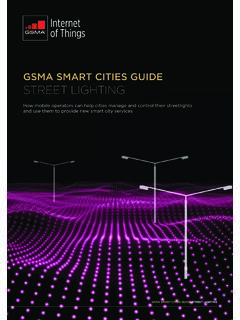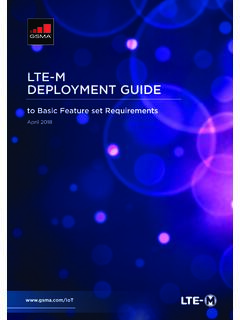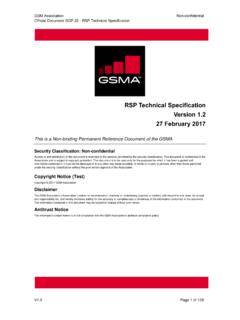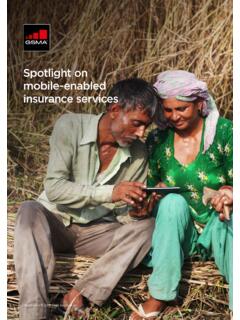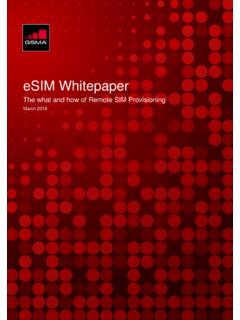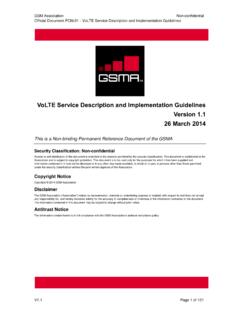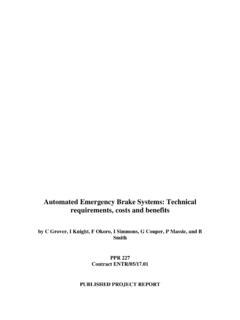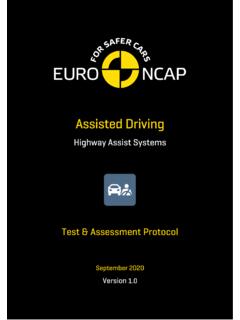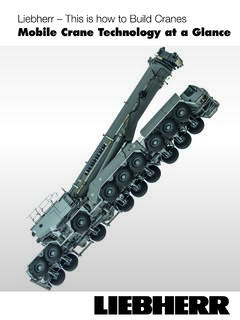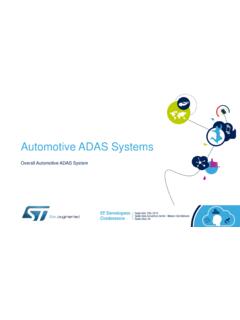Transcription of Cellular VehiCle-to-eVerything (C-V2X)
1 Cellular VehiCle-to-eVerything (C-V2X) enabling intelligent transport Executive SummaryIn June 2017, 3 GPP completed the standardisation of Cellular VehiCle-to-eVerything (C-V2X) technology. Based on LTE, this Cellular technology is designed to connect vehicles to each other, to roadside infrastructure, to other road-users and to cloud-based C-V2X? Many automakers are adding C-V2X connectivity to their vehicles because it has several key advantages over earlier technologies designed to enable vehicle-to-vehicle communications. It can: Leverage the comprehensive coverage of secure and well-established LTE networks Enable highly reliable, real-time communication at high speeds and in high-density traffic Support both short-range and long-range transmissions between vehicles and roadside infrastructure It is part of the roadmap to 5G connectivityCombining secure wide area and short-range connectivity in one module, C-V2X is a versatile and cost-effective solution for automakers looking to improve road safety.
2 C-V2X will enable drivers to benefit from a wide range of compelling services, including pay-as-you drive insurance, vehicle diagnostics, eCall and connected infotainment, as well as an array of safety features. Moreover, harnessing the existing Cellular infrastructure reduces the amount of roadside infrastructure that needs to be installed and maintained by municipalities and highway agencies in both urban and rural areas. Crucially, C-V2X also leverages the robust security built into Cellular employs two complementary trans-mission modes:1. Direct communications between vehicles, between vehicles and infrastructure, and vehicles and other road users, such as cyclists and pedestrians. In this mode, C-V2X works independently of the Cellular Network communications, in which C-V2X employs the conventional mobile network to enable a vehicle to receive information about road conditions and traffic in the promises to transform information and safety services on highways and within cities both by connecting individual vehicles and by enabling the development of cooperative intelligent transport systems (C-ITS) that reduce congestion and pollution and enhance travel.
3 It will help cities to become smarter and support increasingly automated transport systems that are safer and more efficient than today s : ENABLING INTELLIGENT TRANSPORT 1 How C-V2X Could Change DrivingC-V2X can be used in many different ways to improve road safety, while making more efficient use of transport networks and infrastructure. For example, it could support: Platooning: The formation of a convoy in which the vehicles are much closer together than can be safely achieved with human drivers, making better use of road space, saving fuel and making the transport of goods more efficient. Co-operative driving: Vehicles can use C-V2X to work together to minimise the disruption caused by lane changes and sudden braking . Queue warning: Roadside infrastructure can use C-V2X to warn vehicles of queues or road works ahead of them, so they can slow down smoothly and avoid hard braking .
4 Avoiding collisions: Each vehicle on the road could use C-V2X to broadcast its identity, position, speed and direction. An on-board computer could combine that data with that from other vehicles to build its own real-time map of the immediate surroundings and alert the driver to any potential collisions. Hazards ahead warning: C-V2X can be used to extend a vehicle s electronic horizon, so it can detect hazards around a blind corner, obscured by fog or other obstructions, such as high vehicles or undulations in the landscape. Increasingly autonomous driving: Along with other sensors and communications systems, C-V2X will play an important role in enabling vehicles to become increasingly autonomous. Collecting road tolls: designed to reduce congestion and the impact of motor transport on the environment2C-V2X: ENABLING INTELLIGENT TRANSPORT The Roadmap For DeploymentC-V2X has the support of almost all mobile operators, leading mobile equipment makers and automakers including Audi, BMW, Daimler, Ford, PSA, SAIC, Tesla and Toyota.
5 Mobile operators, equipment suppliers and automakers are teaming up to run trials of C-V2X, ahead of the first commercial deployments towards the end of 2018. China is on course to be one of the first countries to deploy C-V2X, while some European countries are also likely to be in the vanguard of , for example, has run trials with China Mobile, SAIC Motor Corporation, Deutsche Telecom, Audi and Toyota, including a live demonstration at the G20 Summit in Hangzhou in September 2016. In February 2017, Orange and PSA Group announced the completion of initial C-V2X field trials in France and are now running further tests with Qualcomm. Trials are also underway in Germany, where Audi, Ericsson, Qualcomm, SWARCO Traffic Systems and the University of Kaiserslautern, have formed the Connected Vehicle to Everything of Tomorrow (ConVeX).
6 In October 2017, AT&T, Ford, Nokia and Qualcomm announced trials in San Diego to demonstrate the potential of C-V2X technologies to improve automotive safety, enable automated driving, and increase traffic is designed to be fully compatible with forthcoming 5G mobile technologies, meaning investments in infrastructure and modules today will be future-proof. C-V2X technology will be further refined and its capabilities expanded with Release 15 of the 3 GPP standards, due in June 2018, and Release 16 in June 2019. C-V2X is designed to be fully compatible with forthcoming 5G mobile technologies, meaning investments in infrastructure and modules today will be future-proof C-V2X: ENABLING INTELLIGENT TRANSPORT 3In the 5G era, C-V2X will be able to support a range of advanced safety services, including very precise positioning and ranging to enable cooperative and automated driving, the delivery of local, dynamic maps based on camera and sensor data, and the very low latency connectivity necessary to enable high-density platooning.
7 As 5G will be able to support very large numbers of connections in a small area, individual vehicles will be able to capture more data about their immediate surroundings. Ultimately, C-V2X will play a pivotal role in enabling the deployment of fully autonomous vehicles, which will transform the way people , C-V2X will play a pivotal role in enabling the deployment of fully autonomous vehicles, which will transform the way people travel4C-V2X: ENABLING INTELLIGENT TRANSPORT 1. IntroductionThe connected vehicle market continues to grow rapidly. Advances in mobile technologies are enabling drivers and passengers to benefit from increasingly sophisticated infotainment, navigation, safety and telematics services. As demand rises around the world, the connected vehicle market is one of the fastest growing segments of the Internet of Things, potentially generating application revenue of US$273 billion by 2026, according to Machina Research s Vehicle to Everything (C-V2X) TechnologyMore than 800 mobile operators around the world have deployed networks that are compatible with the 3 GPP standards, enabling them to benefit from global interoperability and economies of scale.
8 In June 2017, 3 GPP finalised Cellular VehiCle-to-eVerything (C-V2X) technology in Release 14 of its standards. Based on LTE, this Cellular technology is designed to deliver safety and information services to vehicles, paving the way for the development of cooperative intelligent transport systems (C-ITS) that reduce congestion and pollution, while making travel faster and more paper explains what C-V2X is, what it does, how it works, why it is important and why it is well suited to enabling communications between vehicles, roadside infrastructure and other road users. The paper is written as a guide for automakers, mobile operators, equipment vendors, policymakers and regulators. The Role of the GSMAThe GSMA is working with mobile operators, automakers and suppliers, relevant industry associations and regulatory bodies to accelerate the growth of the connected vehicle market by agreeing a common approach to security, regulatory and infrastructure solutions.
9 Only a standardised and collaborative approach can unlock the full potential of this market. The GSMA is consulting with global regulatory bodies to align the industry around a common approach to security and spectrum : Machina ResearchPOTENTIAL APPLICATION REVENUE OF CONNECTED VEHICLE MARKET IN 2026$273 BILLION2026C-V2X: ENABLING INTELLIGENT TRANSPORT 52. How Mobile Networks Can Improve Road Safetyin the connected vehicle ecosystem to implement a proven and robust approach to operators bring a number of assets to this market, including: Broad coverage via existing Cellular net works and mobile ecosystem support Extensive experience in deploying, managing, and maintaining complex communication systems Complementary services, such as navigation, pay-as-you-drive insurance and vehicle diagnostics Public key infrastructure (PKI) certificate management Data storage and data analyticsThe latest vehicles on the world s roads contain very advanced information and communications technologies, including on-board computers, a wide range of sensors and, in many cases, both short-range and wide area connectivity.
10 Many new vehicles rely on Cellular networks to deliver a broad range of infotainment and telematics services, including pay-as-you drive insurance, navigation and automated emergency calling. In particular, mobile networks are playing an increasingly important role in improving road safety and enhancing safety-critical systems on-board well as making individual journeys safer, connected vehicles can deliver broader benefits for society by helping people to choose the most efficient form of transport and the quickest routes, while enabling the collection of automated road tolls designed to reduce congestion, carbon emissions and the impact of transport on the experienced, trusted and licensed providers of connectivity, mobile operators are capable of meeting the automotive industry s need for scalable, secure and proven solutions.

